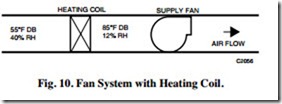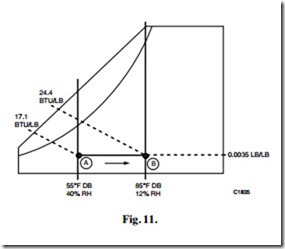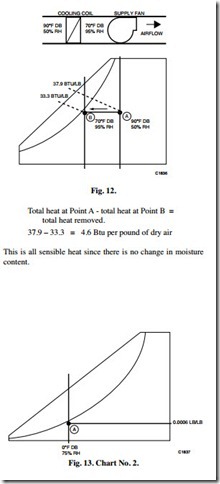AIR CONDITIONING PROCESSES
HEATING PROCESS
The heating process adds sensible heat to the system and follows a constant, horizontal moisture line. When air is heated by a steam or hot water coil, electric heat, or furnace, no moisture is added. Figure 10 illustrates a fan system with a heating coil. Figure 11 illustrates a psychrometric chart for this system. Air is heated from 55F dry bulb to 85F dry bulb represented by Line A-B. This is the process line for heating. The relative humidity drops from 40 percent to 12 percent and the moisture content remains 0.0035 pounds of moisture per pound of air. Determine the total heat added as follows:
1. Draw diagonal lines parallel to the constant enthalpy lines from Points A and B to the enthalpy scale.
2. Read the enthalpy on the enthalpy scale.
3. Calculate the enthalpy added as follows:
Total heat at Point B – total heat at Point A = total heat added.
24.4 – 17.1 = 7.3 Btu per pound of dry air
Since there is no change in moisture content, the total heat added is all sensible. Whenever the process moves along a constant moisture line, only sensible heat is changed.
COOLING PROCESS
The cooling process removes sensible heat and, often, latent heat from the air. Consider a condition where only sensible heat is removed. Figure 12 illustrates a cooling process where air is cooled from 90F to 70F but no moisture is removed. Line represents the process line for cooling. The relative humidity in this example increases from 50 percent (Point A) to 95 percent (Point B) because air at 70F cannot hold as much moisture as air at 90F. Consequently, the same amount of moisture results in a higher percentage relative humidity at 70F than at 90F. Calculate the total heat removed as follows:


